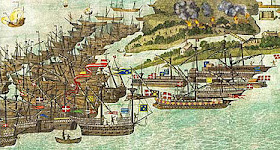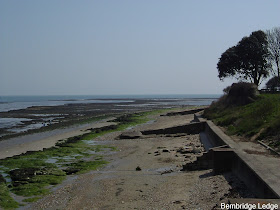“The very notion of anyone invading the
Isle of Wight seems absurd and even, much like the island itself, a bit quaint…
With its benign climate, agricultural fertility, excellent ice-cream and
numerous B&B establishments, it would suit a committed group of idealists
bent on establishing a utopian societal model… But the best reason for
invading the Isle of Wight is that they definitely won’t be expecting it.”
James MayHow to Land an A330 Airbus: and Other Vital Skills for the Modern Man
 |
| The French fleet attacks Bembridge, Isle of Wight |
 |
| Modern day Bembridge (photo author's own) |
This post is not an
exhaustive account of the history of invasion, but more a reflection on three
interesting events in the history of the island. Situated off the South Coast
of England, in the Solent, the Isle of Wight gave the would-be-invader of the
mainland a huge strategic advantage. With sheltered harbours, plentiful fresh
water and good agricultural land, it was the perfect place for an invading army
to regroup and refuel before launching a major assault on England.
 |
| Carisbrooke Castle from the road (author's own photo) |
Between 1336 and 1370 they raided the island five times. But in 1377 they became bolder still. Key to defense of the IOW was Carisbrooke Castle. The French invaded in strength to the north, laying waste to Yarmouth and Francheville, before laying siege to the castle. The attacking force used trebuchets, ladders and crossbows but the story goes that they were defeated by a lone English bowman, Peter de Heynoe.
 |
| View from the ramparts of Carisbrooke Castle (author's own photo) |
The Threat in Tudor Times
During the 16th
century at various times both the French and the Spanish posed threats at
various times. King Henry VIII decided it was time to invest in the Island
defenses and built coast forts at Cowes, Sandown, St Helens and Yarmouth –
sometimes using stone from dissolved monasteries. Carisbrooke Castle became used as a munitions
store.  |
| Priory Bay - IOW One of the many beautiful coves to be found on the island - as good a reason as any to invade! (Author's own photo) |
It was during one of these skirmishes between the English and the French, that the Mary Rose was lost in 1545. From his viewpoint at Southsea Castle, looking across the Solent with the IOW clearly visible, King Henry VIII watched his flagship lead the attack on galleys of the French invasion fleet, only to see the Mary Rose founder and sink.
During Elizabeth I’s reign, an example of the key position played by the IOW was the dramatic sight, on the morning of 26 July 1588, of the Spanish Armada sailing in waters off the islands coast.
“This morning began a great fight between both fleets…[which] were out of sight by three in the afternoon.”
Sir George Carey. (Captain of Carisbrooke Castle under Elizabeth I)
Trivia
alert! George Carey was the grandson of Mary Boleyn (sister of Anne Boleyn),
and Elizabeth I’s cousin
 |
| A Palmerston fort viewed from Southsea Castle, on the mainland, looking across the Solent with the Isle of Wight clearly visible. (Author's own photo) |
The Palmerston Forts or Follies?
From the north coast of the Isle of Wight a number of marine forts are clearly visible, built in the waters of the Solent, with the
purpose of protecting the Solent. These forts were built in Victorian times on
the recommendation of the 1860 Royal Commission on the Defence of the United
Kingdom. There was a parliamentary debate about whether the cost of their
construction could be justified and the cause was championed by the then Prime
Minister, Lord Palmerston. However, it seemed he jumped the wrong way because
by the time they were completed the French threat of invasion had passed, and
the weapons technology with which they were equipped was outdated – hence the nickname
Palmerston’s Follies.  |
| My husband in the foreground on a 'walk to the fort' - traversing a gravel path that becomes visible only at extreme low tide. Palmerston fort in the background. |
I find these forts fascinating. They are clearly visible in
the Solent and have a definite ‘presence’. At certain times of the year the
tide is low enough to ‘walk to the fort’ – along the seabed – I’ve done this a
couple of times and it has a biblical feel about it, with the sea lapping at
your ankles on either side.


I think James May forget the other problem with invading the Isle of Wight: all the pirates (and privateers, smugglers etc.) It was an international centre for such trade for centuries.
ReplyDeleteThanks for the post - it takes me back a bit!
I've often wondered how much smuggling still goes on in and around the island.
DeleteThank you for visiting, VH,
G x